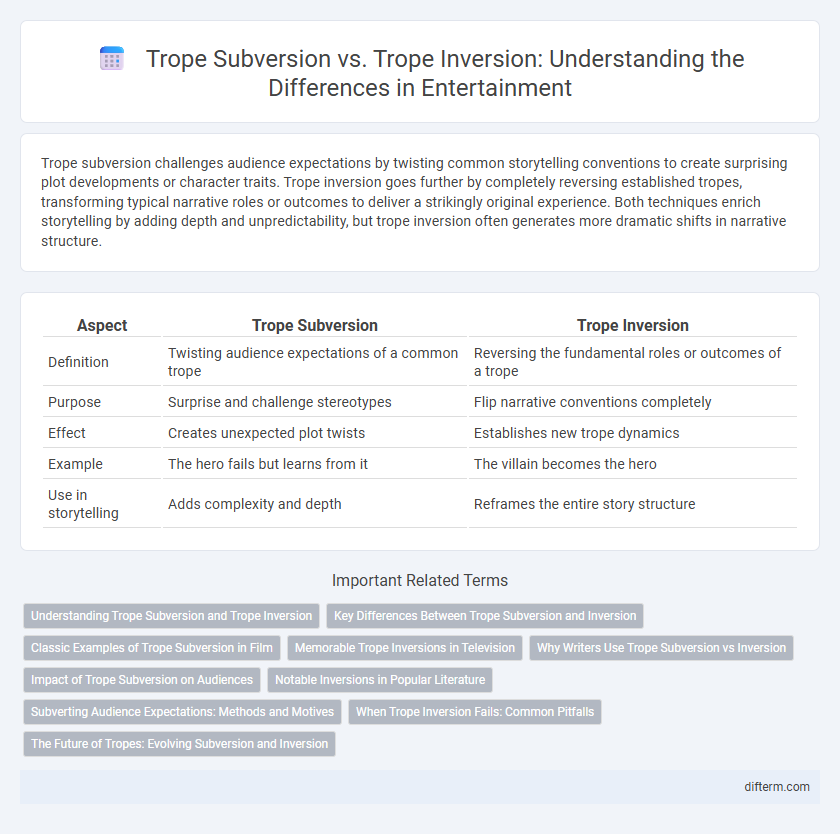Trope subversion challenges audience expectations by twisting common storytelling conventions to create surprising plot developments or character traits. Trope inversion goes further by completely reversing established tropes, transforming typical narrative roles or outcomes to deliver a strikingly original experience. Both techniques enrich storytelling by adding depth and unpredictability, but trope inversion often generates more dramatic shifts in narrative structure.
Table of Comparison
| Aspect | Trope Subversion | Trope Inversion |
|---|---|---|
| Definition | Twisting audience expectations of a common trope | Reversing the fundamental roles or outcomes of a trope |
| Purpose | Surprise and challenge stereotypes | Flip narrative conventions completely |
| Effect | Creates unexpected plot twists | Establishes new trope dynamics |
| Example | The hero fails but learns from it | The villain becomes the hero |
| Use in storytelling | Adds complexity and depth | Reframes the entire story structure |
Understanding Trope Subversion and Trope Inversion
Trope subversion involves taking a familiar storytelling convention and twisting audience expectations by delivering an unexpected outcome, often to create surprise or depth. Trope inversion directly flips the original trope's meaning or roles, turning typical character traits or plot outcomes completely upside down to challenge traditional narratives. Understanding the difference highlights how writers manipulate familiar elements to innovate genre storytelling and engage viewers through clever reinterpretations.
Key Differences Between Trope Subversion and Inversion
Trope subversion challenges audience expectations by presenting familiar narrative elements in unexpected ways, often highlighting irony or complexity. Trope inversion actively reverses the standard roles or outcomes associated with a trope, creating a direct opposition to traditional storytelling conventions. Understanding these key differences enhances the analysis of character development and plot dynamics within films, TV shows, and literature.
Classic Examples of Trope Subversion in Film
Classic examples of trope subversion in film often challenge audience expectations by altering familiar narrative patterns without completely reversing their original meaning. For instance, in the movie *The Sixth Sense*, the trope of the "helpful child" is subverted by revealing that the child can see and communicate with ghosts, shifting the typical role from innocent to pivotal plot driver. Another notable example is *Get Out*, where the trope of the sheltered protagonist is subverted to expose social horror and racial commentary, transforming a predictable narrative into a profound cultural critique.
Memorable Trope Inversions in Television
Memorable trope inversions in television redefine audience expectations by flipping familiar narrative conventions, such as a villain becoming a hero or a predictable romantic subplot evolving into a complex rivalry. Unlike trope subversion, which subtly challenges stereotypes without fully reversing them, trope inversion delivers a direct and striking reversal that reshapes character arcs and plot trajectories. Notable examples include Breaking Bad's transformation of Walter White from protagonist to antagonist and Game of Thrones' unexpected deaths that subvert traditional heroic journeys.
Why Writers Use Trope Subversion vs Inversion
Writers use trope subversion to challenge audience expectations by twisting familiar narrative elements, creating surprise and deeper engagement without completely overturning the trope's original intent. Trope inversion goes further by reversing the fundamental meaning or outcome of a trope, often highlighting themes or critiques more explicitly. Choosing subversion or inversion depends on the desired effect: subtle complexity or bold thematic statement.
Impact of Trope Subversion on Audiences
Trope subversion challenges audience expectations by presenting familiar narrative elements in unexpected ways, creating surprise and deeper engagement with the story. Unlike trope inversion, which reverses traditional roles or outcomes, subversion adds complexity and often prompts viewers to reconsider genre conventions and character archetypes. This approach can lead to heightened emotional responses and increased critical thinking, enhancing the overall entertainment experience.
Notable Inversions in Popular Literature
Notable trope inversions in popular literature often challenge readers by completely reversing expected character roles or narrative outcomes, such as the hero becoming the antagonist or the damsel rescuing the prince. Classic examples include George R.R. Martin's "A Song of Ice and Fire," where heroic archetypes are subverted through unexpected deaths and moral ambiguity, and Suzanne Collins' "The Hunger Games," which inverts the savior trope by showcasing a reluctant protagonist. These inversions deepen thematic complexity and engage audiences by disrupting conventional storytelling patterns.
Subverting Audience Expectations: Methods and Motives
Trope subversion involves deliberately challenging audience expectations by presenting familiar storytelling elements in unexpected ways, often to create surprise or provoke thought. Writers employ techniques such as reversing character roles, undermining genre conventions, and altering anticipated plot outcomes to foster deeper engagement and critique traditional narratives. These methods motivate audiences to reconsider stereotypes and cliches, enriching the entertainment experience through innovation and unpredictability.
When Trope Inversion Fails: Common Pitfalls
Trope inversion fails when it sacrifices character consistency and narrative coherence for shock value, leading to audience disengagement. Misinterpreting trope expectations can result in inversions that feel forced or gimmicky rather than insightful or fresh. Common pitfalls include ignoring the original trope's function, which undermines story impact and reduces emotional resonance.
The Future of Tropes: Evolving Subversion and Inversion
Trope subversion challenges audience expectations by altering familiar narrative patterns while maintaining their core elements, creating surprising and fresh storytelling experiences. Trope inversion goes further by flipping traditional roles or outcomes entirely, offering a complete role reversal that redefines genre conventions. The future of tropes lies in blending subversion and inversion techniques, enabling creators to craft innovative narratives that resonate with contemporary audiences seeking complexity and originality.
trope subversion vs trope inversion Infographic

 difterm.com
difterm.com